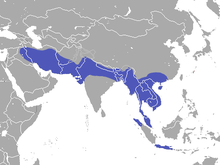Lasun Jawa: Béda antarrépisi
Dijieun ku cara narjamahkeun kaca "Javan mongoose" |
(taya bédana)
|
Révisi nurutkeun 13 Maret 2020 03.08
| Javan mongoose | |
|---|---|

| |
| Status konservasi | |
| Klasifikasi ilmiah | |
| Karajaan: | Animalia |
| Filum: | Chordata |
| Kelas: | Mammalia |
| Ordo: | Carnivora |
| Subordo: | Feliformia |
| Kulawarga: | Herpestidae |
| Génus: | Herpestes |
| Spésiés: | H. javanicus
|
| Ngaran binomial | |
| Herpestes javanicus (É. Geoffroy Saint-Hilaire, 1818)
| |
| Subspecies | |
|
H. j. javanicus | |

| |
| Javan mongoose range | |
| Javan mongoose | |
|---|---|

| |
| Scientific classification | |
| Kingdom: | Animalia |
| Phylum: | Chordata |
| Class: | Mammalia |
| Order: | Carnivora |
| Suborder: | Feliformia |
| Family: | Herpestidae |
| Genus: | Herpestes |
| Species: | H. javanicus
|
| Binomial name | |
| Herpestes javanicus (É. Geoffroy Saint-Hilaire, 1818)
| |
| Subspecies | |
|
H. j. javanicus H. j. auropunctatus H. j. exilis H. j. orientalis H. j. pallipes H. j. palustris H. j. peninsulae H. j. perakensis H. j. rafflesii H. j. rubifrons H. j. siamensis H. j. tjerapai | |

| |
| Javan mongoose range | |
Lasun Jawa (Herpestes javanicus) nyaéta spésiés lasun pituin Asia Kidul jeung Asia Tenggara, tapi geus sumebar ka mana-mana.
Taksonomi
Ngaran ilmiah awalna Ichneumon javanicus, diusulkeun ku Étienne Geoffroy Saint-Hilaire taun 1818.[2] Abad ka-19 jeung ka-20, sababaraha spésimén zoologi ayeuna dianggap sarua:
- Mangusta auropunctata (1836) ku Brian Houghton Hodgson, spésimén ti Népal tengah.[3]
- Herpestes exilis (1841) ku Paul Gervais, spésimén ti Tourane di Vietnam.[4]
- Mangusta pallipes (1845) ku Edward Blyth, ti Kandahar, Apganistan. [5]
- Mungos rubifrons (1909) ku Joel Asaph Allen, dalapan spésimén sawawa ti Pulo Hainan, Cina.[6]
- Mungos exilis peninsulae (1910) ku Ernst Schwarz ti Bangkok.[7]
- Mungos siamensis (1917) ku Cecil Boden Kloss ti kalér Thailand. [8]
- Herpestes palustris (1965) ku RK Ghose ti Kolkata, India. [9]
Subspésiés lasun Jawa anu dipikawanon kiwari: [ <span title="This claim needs references to reliable sources. (February 2020)">rujukan?</span> ]
- H. j. javanicus
- H. j. auropunctatus
- H. j. exilis
- H. j. orientalis
- H. j. usuk
- H. j. palustris (lasun Bengali)
- H. j. seménanjung
- H. j. perakensis
- H. j. rafflesii
- H. j. rubrifrons
- H. j. siamensis
- H. j. tjerapai
Pilogeni
Analisis DNA mitokondria mendakan yén grup Asia Tenggara subspesies mongoose Jérman Tenggara bénten sacara genetik tina jinis mongoose Java anu langkung tebih di kulon. Walungan Salween di Myanmar panginten janten panghalang antara dua kelompok. [10]
- ↑ a b Chutipong, W.; Duckworth, J. W.; Timmins, R.; Willcox, D. H. A.; Ario, A. (2016). "Herpestes javanicus". IUCN Red List of Threatened Species (IUCN) 2016: e.T70203940A45207619. https://www.iucnredlist.org/species/70203940/45207619. Salah ngutip: Tanda
<ref>tidak sah; nama "iucn" didefinisikan berulang dengan isi berbeda - ↑ Geoffroy Saint-Hilaire, É. (1818). "De l'Ichneumon. Ichneumon pharaon". Di Jomard, E. F. Description de l'Égypte, ou, Recueil des observations et des recherches qui ont été faites en Égypte pendant l'éxpédition de l'armée française. Tome II. Paris: l'Imprimerie Royale. pp. 137–144.
- ↑ Hodgson, B. H. (1836). "Synoptical description of sundry new animals, enumerated in the Catalogue of Nipalese Mammals". Journal of the Asiatic Society of Bengal 5 (52): 231–238. https://archive.org/details/journalofasiatic05asia/page/235/mode/1up.
- ↑ Gervais, P. (1841). "Observations géologiques et anatomiques sur diverses espèces de Mammifères nouveaux ou peu connus". Extraits des procès-verbaux des séances 6: 101–103. https://archive.org/details/extraitsdesproc46183941soci/page/102/mode/1up.
- ↑ Blyth, E. (1845). "Additions and corrections to Rough notes on the Zoology of Candahar and the neighbouring districts by Thomas Hutton". Journal of the Asiatic Society of Bengal 15 (170): 169–170. https://archive.org/details/journalofasiatic15asia/page/168/mode/2up.
- ↑ Allen, J. A. (1909). "Further notes on mammals from the Island of Hainan, China". Bulletin of the American Museum of Natural History 26 (17): 239–242. http://digitallibrary.amnh.org/bitstream/handle/2246/465//v2/dspace/ingest/pdfSource/bul/B026a17.pdf?sequence=1&isAllowed=y.
- ↑ Schwarz, E. (1910). "Two new Oriental Viverridae". The Annals and Magazine of Natural History; Zoology, Botany, and Geology. 8 6 (32): 230–232. https://archive.org/details/annalsmagazineof861910lond/page/230/mode/2up.
- ↑ Kloss, C. B. (1917). "On a new Mongoose from Siam". The Journal of the Natural History Society of Siam 2 (3): 215–217. https://archive.org/details/journalofnatural02natu/page/214/mode/2up.
- ↑ Ghose, R. K. (1965). "A new species of mongoose (Mammalia: Carnivora: Viverridae) from West Bengal, India". Proceedings of the Zoological Society of Calcutta 18 (2): 173–178.
- ↑ Patou, M. L.; Mclenachan, P. A.; Morley, C. G.; Couloux, A.; Jennings, A. P.; Veron, G. (2009). "Molecular phylogeny of the Herpestidae (Mammalia, Carnivora) with a special emphasis on the Asian Herpestes". Molecular Phylogenetics and Evolution 53 (1): 69–80. https://www.researchgate.net/publication/26286265_Molecular_phylogeny_of_the_Herpestidae_Mammalia_Carnivora_with_a_special_emphasis_on_the_Asian_Herpestes.

